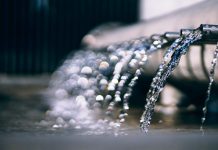
Find out which Menards water softener is the right option for your home.
Our unbiased Menards water softener review compares the best single and dual-tank water softener models as well as anti-scale and rust models for reducing mineral build-up in pipes.
Discover different features and materials you can use to soften the water in your home.
Water softeners significantly improve the quality of the water in your home by limiting the presence of hard minerals in your water, such as calcium, magnesium, and manganese. Hard water can cause deposits to form in pipes and on surfaces in your home. Excess minerals can take a toll on skin and hair, degrade the color and quality of clothing, or leave residue on dishes.
Menards is a home maintenance and supply store that sells a variety of water softener tanks as well as salt for maintaining these appliances. Menards water softener tanks include models from Morton, OMNIFiler, Scalewatcher, and WaterBoss.
Learn more about the best options available with our Menards water softener review.
What are Menards Water Softeners?
Water softeners rely on resin beads to filter out hard water. These systems use salt to clean the resin beads within the tank during regeneration cycles.
This allows the resin beads to continue to be able to reduce mineral content in your water supply. In order to soften the water in your home, you will need to purchase and connect a water softener tank and use sodium chloride or potassium chloride to maintain the functionality of the grains or resin balls in the tank.
In addition to water softeners, we also cover several anti-scale and rust units available at Menards. These appliances will also make a significant difference in the hardness of water, control mineral buildup in pipes, and may require less maintenance than the types that use brine tanks.
Product Specifications
There are a number of specifications that you should consider when choosing a Menards water softener.
From the grain capacity and salt capacity of a tank to the maximum water hardness limit with a functioning unit installed, different styles of water softeners from various manufacturers vary in ways that may make a certain tank the right or wrong choice for your needs.
Grain Capacity
The grain capacity of a water softener refers to the number of grains of water hardness the unit can remove in between regeneration sessions. Water hardness is measured in grains per gallon, with one grain of hardness equating to 1/7,000 pound. Water with one gpg is equal to 17.1 milligrams per liter or parts per million.
In general, water softeners with 16,000 to 20,000 grains are suitable for use in studio apartments, campers, tiny houses, or other housing units where not much water is used.
If two or three people live in your home and you want to soften the water in sinks and showers, you may choose a unit with a grain capacity in the 20,000 to 30,000 range, depending on the hardness of the water in your locality.
A Menards water softener with a grain capacity in the 30,000 to 40,000 range is suitable for homes with three to four people and a dishwasher and washing machine in addition to sinks and bathrooms. If more than four people live in your home, you should consider a larger unit with a grain capacity of 40,000 or above.
The grain capacity of the water softener you choose will impact how frequently the system will need to regenerate. To achieve maximum efficiency, you should restrict your search to the appliances that should be capable of removing hardness from water for a full week before needing to regenerate.
Tank Design
When you choose a Menards water softener, you have the option to select a cabinet-style or twin-tank model.
Most of the alternatives available for sale are cabinet style, as these designs are compact and may require less salt and water than older systems or twin-tank systems. Additionally, most cabinet-style units feature a resin tank and brine tank within one protective housing. These systems often monitor water usage in order to provide softening on demand.
Twin-tank water softeners feature two resin tanks, which makes it possible for one tank to regenerate while the other continues to soften the water flowing to appliances, sinks, and showers in your home.
Twin-tank models often have higher grain capacities, as they are intended for use in homes with four or more residents. These models typically take up more space and cost more than cabinet-style softener systems. At the same time, you will never have to wait for a twin-tank softener to finish regenerating.
Regeneration
Most Menards water softener models will need to regenerate whenever the resin bed within becomes coated with hardness removed from water.
The frequency of regeneration may depend on the settings you specify on your unit. An appropriately sized unit should regenerate at least every one to two weeks. More frequent regeneration can waste water and salt or potassium chloride, while less-frequent regeneration can cause resin in the softener unit to compact or become corrupted with sediment.
Some units also allow users to schedule regeneration at times when this process will not interfere with the availability of soft water for daily tasks.
Regeneration methods vary depending on whether your water softener relies on an additive, such as sodium chloride or potassium chloride. In addition to salt or potassium chloride, some water softener owners also regularly use specially formulated cleaners to eliminate iron buildup and prevent fouling of the resin in the softener tank.
You should ensure that your water softener has all of the salt or chemicals necessary for regeneration. Check the level of sodium chloride or potassium chloride in the brine tank at least once a month. You can also use an automatic feeder or manually add a cleaner during the regeneration process to ensure that your softener is as clean and efficient as possible.
Sodium Chloride or Potassium Chloride
Water softeners may rely on sodium chloride or potassium chloride to reduce the presence of hard minerals in water.
When a brine solution that contains sodium chloride washes over the resin in the tank, the hard mineral ions in the water are replaced with sodium. Companies, such as Morton, sell large quantities of sodium chloride intended for use in brine tanks. Customers may have the option to choose between salt in blocks, crystals, cubes, or pellets.
Salt is the most affordable supply for maintaining a water softener.
The use of sodium chloride does add trace amounts of sodium to water. This can affect individual drinkers with high blood pressure or other health issues and can even raise salt levels in local drinking water supplies.
Some municipalities restrict the use of sodium, as it may have unintended environmental effects.
If sodium is not used, some other kind of Menards water softener cleaner is necessary to ensure that systems continue to function at maximum efficiency. You may also use potassium chloride, a sodium-free chemical used for water softening.
This chemical can substantially reduce the presence of sodium in water systems. Potassium chloride is also effective and inexpensive and can be used in most water softener units.
Potassium chloride is also naturally occurring. Its effects on softened water vary as it replaces minerals in hard water with potassium instead of sodium. Individuals with certain medical conditions who must limit potassium intake should weigh the effects of sodium chloride and potassium chloride and choose the best option.
Iron Reduction
The presence of as little as 0.3 parts per million of iron in water can cause staining, lead to pipe blockage, and affect the taste of water. Some water softeners that are rated for iron reduction can help to remove both hardness and iron from water. Keep in mind that other softeners may not be able to limit these dissolved organic iron compounds that are not filtered out by either ion exchange or resin filtration.
Ferrous iron should be discharged with other minerals during brine regeneration. However, some of this iron can be converted to a ferric insoluble state by oxygen in the brine or water and remain in the softener. This can lead to fouling.
If your water supply has high iron levels or you have noticed build-up, you may want to consider using a chemical cleaner designed for eliminating traces of iron on a regular basis.
Salt Capacity
A properly sized water softener for a residential system should go through about 10 pounds of salt per week, for a total of roughly 40 pounds of salt each month. It is a good idea to regularly check the amount of salt in the brine tank of a water softener to ensure that the system has a sufficient amount of sodium chloride or potassium chloride to operate effectively.
The brine tank in most Menards water softener designs should be filled at least one-quarter full with salt in order to operate and recharge efficiently. The salt level in this tank should always remain a few inches above the water level. It is a good idea to break up large clumps of salt or loosen crusted salt on the edges of the tank.
If the salt in your brine tank fuses into a solid block, use hot water to make the salt easier to break up and remove from the tank. There should usually be several gallons in the bottom of the brine tank, but the total amount for a residential system should not be more than a foot high.
Pricing: Menards Water Softener Review
The features of these softeners vary, which explains the variance in price.
Keep in mind that the alternatives that rely on treatment chemicals or salt will also require that you periodically purchase these additional supplies.
How These Products Compare: Menards Water Softener Review
Pros and Cons: Menards Water Softener
Pros |
Cons |
|---|---|
|
|
Conclusion: Menards Water Softener Review
When it comes to water softeners, the OMNIFilter models sold at Menards and other home maintenance stores and online vendors are excellent options. These easy-to-install models are available with grain capacities ranging from 26,000 to 40,000. The 34,000- and 40,000-grain capacity water softener OMNIFilter models are dual- or twin-tank configurations. This means that you’ll never have to wait for regeneration to finish.
If you want to reduce rust and scale in pipes and on fixtures in your home with less pronounced water-softening benefits, you can’t go wrong with the Calmat Electronic Anti Scale and Rust Water Treatment System. This model is a higher-rated alternative to the Scalewatcher Residential Water Conditioning Unit.
We recommend the dual-tank OMNIFilter 34,000-Grain Water Softener as the best option for most single-family homes with a dishwasher and washing machine. The price point, ease of use, and simple assembly of this Menards water softener set this model apart from the alternatives: twin- or dual-tank configurations and single-tank cabinet-style water softeners alike.
This option also comes with several manufacturer’s warranties, including a two-year warranty on parts, five-year warranty on electronics, and 10-year warranty on resin tanks.
Now that you have read our Menards water softener review, it’s time for you to choose which one is the best.
OMNIFilter 34,000-Grain Water Softener – 4.5 stars




Most people in my area have no clue that fast hair growth amino scalp therapy shampoos (obviously with no sulfates, no parabens or DEA) are even a thing. Folks can now have longer hair and achieve more possibilities. For sure worth researching.
Whether you’re considering alopecia, hair damage, preventing hair disorders, hair growth, hair care generally, almost the same principles become relevant.
As a rule of thumb, you want to avoid hair treatments and products that include chemicals such as parabens, DEA and sulfates.
What’s healthy for your hair is good for your skin as well.
It goes without saying the content on this page is spot on for many reasons. It stays away from the accustomed pitfalls and traps so many fall into- using horrible alternatives. Keep up the great content!